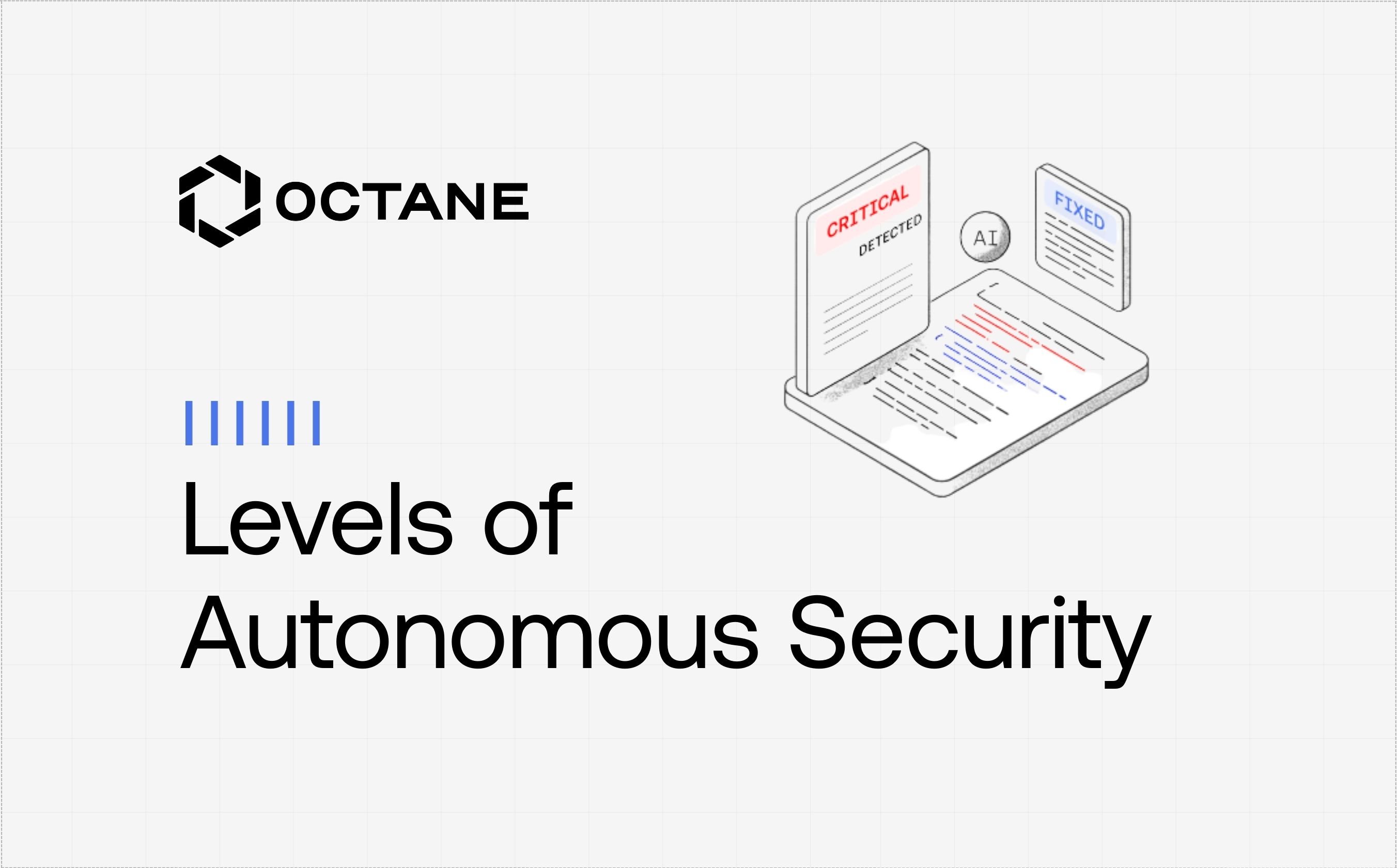Inspired by the evolution of autonomous vehicles, this framework defines the path from manual security to fully autonomous systems. It provides a common language for evaluating and comparing security tools based on their level of autonomy.
Levels of Autonomous Security: Manual Reviews to Self-Healing Systems
Inspired by the evolution of autonomous vehicles, this framework defines the path from manual security to fully autonomous systems. It provides a common language for evaluating and comparing security tools based on their level of autonomy.
Mapping the Future of Autonomous Security
Over the past two years, Octane has analyzed 86 million+ lines of code and detected thousands of vulnerabilities. One question keeps coming up again and again: what does AI security actually mean? Today, we're answering that question.
Inspired by the staged rollout of autonomous driving, from manual to self-driving systems, we’re introducing the Levels of Autonomous Security: a framework that defines the path from manual security to fully autonomous systems.
Just as autonomy in vehicles required trust, clarity, and clear milestones, teams need a shared language to evaluate tools, set expectations, and map progress. This framework is designed to do exactly that.
Why This Framework Now?
Security tools are advancing fast, especially with the rise of AI, but "AI-powered" can mean wildly different things. Some tools still rely on rule-based detection. Others claim agent-like capabilities. Most land somewhere in between.
We created the Levels of Autonomous Security framework to map the path of this evolution. As capabilities expand, security teams and developers need a common language to assess where a tool actually stands, what it can do today, what still requires human input, and what’s coming next. It’s about building clarity and alignment, so teams can choose and integrate solutions with confidence.
Each level introduces a meaningful new capability while clarifying what’s still manual, what’s automated, and where human judgment is still required.
Levels of Autonomous Security

Level 0 - All Human-Driven
There is no automation. All vulnerability discovery, validation, and triage is performed manually by human security researchers.
- Security audits and code reviews are entirely manual
- No automated scanning or detection tools
- Decisions are subjective and inconsistent
- Limited scalability and coverage
Level 0 → Level 1: From fully manual to basic automation
Level 1 - Rule-Based Detection
Tools can handle basic, predefined tasks like identifying known vulnerability patterns through static analysis.
- Rule-based scanning (e.g., linters, SAST tools)
- High volume of findings, low signal-to-noise ratio
- No contextual understanding or validation
- Relies heavily on time-consuming human triage
Level 1 → Level 2: From rules to reasoning assistance
Level 2 - AI-Augmented Detection
Security tools now use large language models or heuristics to improve findings, reduce false positives, and provide better explanations.
- Contextual insights and language-based explanations
- Smarter detection of nuanced or uncommon issues
- Requires human review and judgment to verify outputs
Level 2 → Level 3: From enhancement to autonomous exploration and contextual triage
Level 3 - Discovery + Risk Analysis
AI systems can generate outputs with quality similar to junior security researchers, actively exploring code, identifying vulnerabilities, and validating severity through impact and likelihood assessment.
- Autonomous code exploration across large input space
- Detects multi-step or contextual vulnerabilities
- Validates findings and surfaces real-world risk
- Shifts early triage from human-driven to AI-guided prioritization
Level 3 → Level 4: From validated findings to demonstrated exploitability
Level 4 - Proof-of-Concept Generation
Systems generate working POCs via code or natural language to prove vulnerabilities are real and exploitable, allowing prioritization based on demonstrated risk.
- Generates a custom POC to confirm an issue
- Demonstrates exploitability in real-world environments
- Bridges the gap between vulnerability detection and actionable exploitation
- Requires human review to assess POC validity
Level 4 → Level 5: From demonstrated risk to automated resolution
Level 5 - Autonomous Remediation Recommendations
Systems detect, validate, and recommend remediation without human input, generating safe, test-covered code changes ready for deployment.
- Validated patches with code diffs and tests
- Enables continuous, self-healing systems
- High coverage and high accuracy
Looking Ahead
Our goal in creating the Levels of Autonomous Security is to offer a forward-looking lens into where the industry is headed, bringing greater clarity, alignment, and shared understanding into what’s next. As we continue advancing toward more capable, reliable, and autonomous systems, this framework can help teams evaluate new solutions, benchmark their progress, and make more confident security decisions.
With the right tools and shared language, we can build a future where secure software is the default, not the exception.
.jpg)





